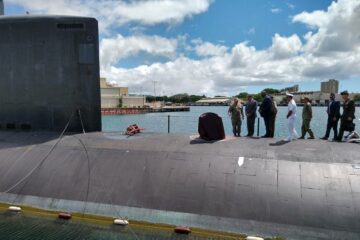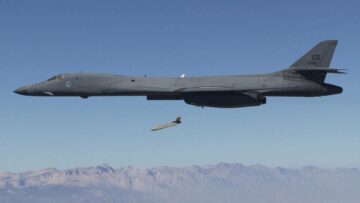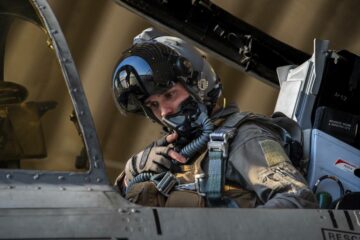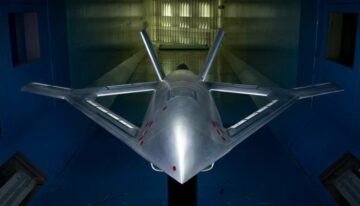
Saab is growing its footprint in the U.S. with a new facility that will manufacture ground combat weapons and missile systems, the head of the company’s American branch told Defense News.
The new site is part of a global manufacturing push from the Swedish company to quadruple its global capacity to produce its ground combat weapons, Erik Smith said in a recent interview.
“We certainly see a very broad and very large market opportunity for the kind of products that we have today and the kinds of products that are being developed right now,” Smith said. “As this facility ramps up, what you will see is a combination of products that Saab is very well known for and some new products that really haven’t hit the market yet.”
The facility will feature advanced manufacturing capability and an innovation center to enhance munitions production capacity stateside, according to Smith. He also said it will support the production of components for the Ground-Launched Small Diameter Bomb, or GLSDB, system as well as close combat weapons.
Saab is in the process of selecting a site, having issued a request for proposals. Six states are in the running, although Smith decline to identify candidates. He said the company plans to choose a site and break ground by the end of 2024, with plans to begin production by 2026.
The company has rapidly expanded its locations across the U.S. in recent years. Last year, the company established two facilities focused on unmanned underwater vehicles in Rhode Island and Massachusetts as well as in California to support its work with U.S. Marine Corps training.
In 2021, Saab opened an advanced aerostructure manufacturing facility in West Lafayette, Indiana, where it builds the rear fuselage for Boeing’s T-7 trainer aircraft.
The company is based in Syracuse, New York, and runs its surveillance side of the business there.
“We’ve had pretty substantial growth in our land systems portfolio,” Smith said, including winning a large contract in 2021 to provide a next-generation force-on-force training system to the Marine Corps.
Additionally, the Air Force awarded a contract to Saab and its partner Boeing for the GLSDB system, which the company began to deliver to the service in 2023.
A year ago, the U.S. pledged to send the GLSDB to Ukraine. The bomb has a range of 93 miles and can be launched from mobile artillery systems like the High Mobility Artillery Rocket System.
For the new facility, the plan is to follow a similar model to what Saab did with its West Lafayette site. In that case, the first engineering and manufacturing development fuselages were built in Sweden, then, in parallel, Saab built the Indiana plant with high-end technology to produce the fuselages beginning with low-rate initial production, Smith explained.
“We’re going to take advantage of some of the advanced technologies that are out there in manufacturing today and the evolution of the manufacturing space and capability since many, including our weapons and ammunition factories, were built many, many years ago,” Smith said. “You can imagine there’s some significant opportunities for efficiency improvement and … capability improvement overall, in terms of building these kinds of systems.”
The facility will not just produce systems but will also have capability to test and integrate capability, he added.
The facility in West Lafayette is about 100,000 square feet and is one of Saab’s larger facilities in the country, but the footprint needed for land combat systems is expected to be “significant,” Smith said.
“I would envision this facility employing hundreds of people,” he added. And like in West Lafayette, the land secured for the facility will allow for a large amount of growth over time, he added.
Saab is the 33rd largest defense contractor in the world, according to Defense News’ Top 100 list.
Jen Judson is an award-winning journalist covering land warfare for Defense News. She has also worked for Politico and Inside Defense. She holds a Master of Science degree in journalism from Boston University and a Bachelor of Arts degree from Kenyon College.
- SEO Powered Content & PR Distribution. Get Amplified Today.
- PlatoData.Network Vertical Generative Ai. Empower Yourself. Access Here.
- PlatoAiStream. Web3 Intelligence. Knowledge Amplified. Access Here.
- PlatoESG. Carbon, CleanTech, Energy, Environment, Solar, Waste Management. Access Here.
- PlatoHealth. Biotech and Clinical Trials Intelligence. Access Here.
- Source: https://www.defensenews.com/industry/2024/03/26/saab-to-expand-us-footprint-with-new-munitions-facility/
- :has
- :is
- :not
- :where
- $UP
- 000
- 100
- 2021
- 2023
- 2024
- 2026
- 70
- 8
- a
- About
- According
- across
- added
- advanced
- ADvantage
- ago
- AIR
- Air Force
- allow
- also
- Although
- American
- ammunition
- amount
- an
- and
- ARE
- Arts
- AS
- award-winning
- awarded
- based
- BE
- began
- begin
- Beginning
- being
- Boeing
- bomb
- boston
- Boston University
- Branch
- Break
- broad
- Building
- built
- business
- but
- by
- california
- CAN
- candidates
- capability
- Capacity
- case
- Center
- certainly
- Choose
- Close
- College
- combat
- combination
- company
- Company’s
- components
- contract
- Contractor
- corps
- country
- covering
- Decline
- Defense
- Degree
- deliver
- developed
- Development
- DID
- efficiency
- employing
- end
- Engineering
- enhance
- envision
- erik
- established
- evolution
- Expand
- expanded
- expected
- explained
- facilities
- Facility
- factories
- Feature
- Feet
- First
- focused
- follow
- Footprint
- For
- Force
- from
- Global
- going
- Ground
- Growing
- Growth
- had
- Have
- having
- he
- head
- High
- High-End
- Hit
- holds
- HTTPS
- Hundreds
- identify
- images
- imagine
- improvement
- in
- Including
- Indiana
- initial
- Innovation
- inside
- integrate
- Interview
- island
- Issued
- IT
- ITS
- journalism
- journalist
- jpg
- just
- Kind
- kinds
- known
- Land
- large
- larger
- largest
- Last
- Last Year
- launched
- like
- locations
- manufacturing
- many
- Marine
- Market
- massachusetts
- master
- Mobile
- mobility
- model
- needed
- New
- new products
- New York
- news
- next-generation
- now
- of
- on
- ONE
- opened
- opportunities
- Opportunity
- or
- our
- out
- over
- overall
- Parallel
- part
- partner
- People
- plan
- plans
- plant
- plato
- Plato Data Intelligence
- PlatoData
- portfolio
- pretty
- process
- produce
- Production
- Products
- Proposals
- provide
- Push
- Ramps
- range
- rapidly
- really
- recent
- request
- right
- rocket
- running
- runs
- s
- Said
- Science
- Secured
- see
- selecting
- send
- service
- she
- side
- significant
- similar
- since
- site
- SIX
- small
- smith
- some
- Space
- square
- States
- substantial
- support
- surveillance
- Sweden
- Swedish
- system
- Systems
- Take
- Technologies
- Technology
- terms
- test
- that
- The
- the world
- then
- There.
- These
- this
- time
- to
- today
- told
- top
- trainer
- Training
- two
- u.s.
- underwater
- university
- us
- Vehicles
- very
- we
- Weapons
- WELL
- were
- West
- What
- which
- will
- winning
- with
- Work
- worked
- world
- would
- year
- years
- yet
- york
- you
- zephyrnet












